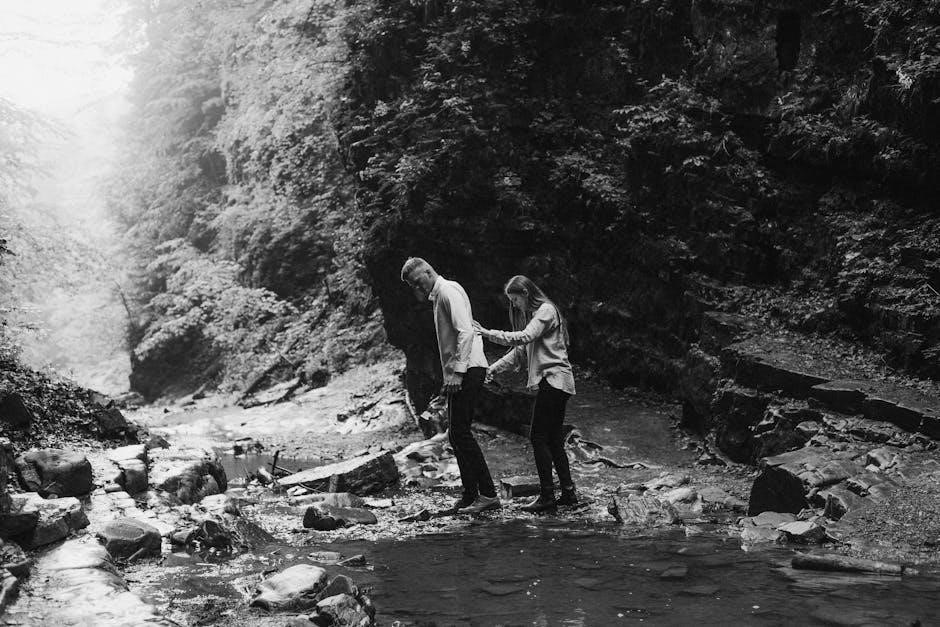crossing the river with dogs pdf
- by stephany

Crossing the River with Dogs is a problem-solving guide for college students, emphasizing collaboration and real-world applications․ It offers practical strategies and resources for effective learning․
1․1 Overview of the Book
Crossing the River with Dogs is a comprehensive guide designed to enhance problem-solving skills in college students․ Focusing on collaboration and real-world applications, it integrates mathematical strategies with practical examples․ The book emphasizes group learning, communication, and teamwork, aligning with workplace demands․ Available in PDF and ePUB formats, it includes a companion website with supplementary materials․ This third edition is widely used in courses like quantitative reasoning and liberal arts mathematics, making it a versatile resource for diverse academic needs․ Its interactive elements and downloadable resources further enrich the learning experience․
1․2 The Unique Title and Its Significance
The title Crossing the River with Dogs is both intriguing and metaphorical, symbolizing teamwork and problem-solving․ It originates from a scenario where a dog’s unique skills enable a challenging crossing, mirroring the book’s focus on creative solutions․ The title reflects the book’s emphasis on collaboration and real-world applications, suggesting that even complex challenges can be overcome with the right strategies and teamwork․ This unique naming helps the book stand out, inviting readers to explore its innovative approach to problem-solving and group learning․
1․3 Importance of Problem Solving in Education
Crossing the River with Dogs underscores the critical role of problem-solving in education, fostering skills essential for academic and professional success․ By integrating real-world scenarios, the book prepares students to tackle complex challenges through collaboration and critical thinking․ Problem-solving enhances creativity, analytical reasoning, and adaptability, equipping learners for future uncertainties․ The text emphasizes teamwork, mirroring workplace dynamics, and encourages students to apply mathematical strategies to practical issues․ This approach not only strengthens academic performance but also cultivates lifelong learning and adaptability, making it a vital component of modern education․
Authors and Their Contributions
Ken Johnson, Ted Herr, and Judy Kysh collaborated on Crossing the River with Dogs, blending their expertise to create a comprehensive guide focused on problem-solving and collaboration skills․
2․1 Ken Johnson: Background and Expertise

Ken Johnson is a renowned author and educator with expertise in problem-solving and mathematics․ His work on Crossing the River with Dogs reflects his commitment to fostering collaboration and critical thinking․ Johnson’s approach emphasizes real-world applications, making complex concepts accessible to students․ His background in education and mathematics equips him to design practical strategies for learners․ By integrating dialogues and case studies, Johnson creates an engaging learning environment․ His contributions have significantly influenced problem-solving education, making him a key figure in the field․
2․2 Ted Herr: His Role in the Book
Ted Herr is a co-author of Crossing the River with Dogs, bringing his expertise in problem-solving and education․ His role involves structuring the book’s content to emphasize collaboration and real-world applications․ Herr’s contributions focus on developing practical strategies for students, ensuring the material is engaging and relevant․ The book’s dialogues among fictitious students, a key feature, reflect his approach to making complex concepts accessible․ His work alongside Ken Johnson and Judy Kysh has made the text a valuable resource for college students, particularly in courses requiring problem-solving and critical thinking skills․
2․3 Judy Kysh: Contributions to the Project
Judy Kysh is a co-author of Crossing the River with Dogs, contributing her expertise in problem-solving strategies and educational methodologies․ Her work focuses on creating engaging, real-world examples that help students apply mathematical concepts․ Kysh emphasizes collaboration and communication, aligning the book’s content with workplace skills․ She also played a key role in developing the dialogues among fictitious students, making complex ideas more relatable․ Her contributions ensure the text is accessible and practical, catering to diverse learning needs and enhancing the overall effectiveness of the problem-solving approach presented in the book․

Structure and Content of the Book
Crossing the River with Dogs is structured into chapters, each focusing on specific problem-solving strategies and real-world applications․ The book integrates mathematical concepts with collaborative learning techniques, emphasizing dialogues among fictitious students to explain both classic and non-traditional methods․ It provides practical examples and case studies, making problem-solving accessible and engaging for college students while fostering essential workplace skills like communication and teamwork․
3․1 Chapter Breakdown and Key Topics
The book is divided into chapters, each focusing on specific problem-solving strategies and real-world applications․ Key topics include mathematical problem-solving, collaboration, and communication skills․ Chapters explore classic and non-traditional methods through dialogues among fictitious students, making complex concepts engaging․ Practical examples and case studies are integrated to illustrate how problem-solving applies to everyday scenarios․ The structure emphasizes hands-on learning, encouraging students to work in groups and develop essential workplace skills․ Each chapter builds on the previous one, creating a comprehensive guide for college students to master problem-solving techniques and apply them across various disciplines․
3․2 Integration of Mathematical Strategies
The book seamlessly integrates mathematical strategies, blending classic and non-traditional methods․ Through dialogues among fictitious students, complex concepts are made accessible․ Real-world applications are emphasized, helping students connect math to practical scenarios․ The text balances mathematical rigor with engaging problem-solving techniques, ensuring students grasp both theory and application․ This approach prepares learners for diverse challenges, fostering critical thinking and adaptability․ The integration of math strategies is tailored to support various learning styles, making the content versatile for different academic needs and courses․
3․3 Real-World Applications of Problem Solving
The book emphasizes real-world applications of problem-solving, making math relevant to students’ lives․ It uses practical examples to illustrate how strategies can be applied in various scenarios․ This approach helps students understand the value of problem-solving in real-life contexts, preparing them for future challenges․ The text is designed to be applicable across disciplines, making it suitable for courses like quantitative reasoning, liberal arts mathematics, and developmental math․ By focusing on real-world relevance, the book bridges the gap between academic concepts and practical implementation, enhancing students’ ability to solve problems effectively in diverse situations․

Problem Solving Strategies Explored
The book explores classic and non-traditional problem-solving methods, using dialogs among fictitious students to explain strategies․ It bridges math with real-world applications, enhancing practical problem-solving skills․
4․1 Classic vs․ Non-Traditional Methods
The book balances classic problem-solving techniques, such as systematic analysis and logical reasoning, with non-traditional approaches like creative thinking and unconventional strategies․ Classic methods are structured and step-by-step, while non-traditional methods encourage innovation and out-of-the-box solutions․ This blend allows students to adapt strategies to various scenarios, fostering versatility in problem-solving․ The integration of both approaches ensures a comprehensive understanding, catering to different learning styles and preferences․ By exploring these methods, students develop a robust skill set applicable to academic and real-world challenges, making the text a valuable resource for diverse problem-solving needs․

4․2 Dialogs Among Fictitious Students
The book employs dialogs among fictitious students to illustrate problem-solving strategies, making complex concepts relatable and engaging․ These conversations mimic real-life discussions, allowing students to witness diverse perspectives and approaches․ By presenting classic and non-traditional methods through these interactions, the authors create a dynamic learning environment․ This approach encourages students to think critically and collaboratively, mirroring real-world teamwork scenarios․ The dialogs also highlight common challenges and misconceptions, providing practical insights and solutions․ This engaging format helps students connect theoretical strategies with practical applications, enhancing their understanding and problem-solving abilities in a collaborative context․
4․3 Case Studies and Practical Examples
Crossing the River with Dogs incorporates real-world case studies and practical examples to illustrate problem-solving techniques․ These scenarios, often relevant to college students’ lives, help bridge theoretical concepts with tangible applications․ The book uses diverse examples to demonstrate how classic and non-traditional strategies can be applied effectively․ By presenting relatable challenges, the authors enable students to practice critical thinking and collaboration․ The inclusion of practical examples also enhances understanding of mathematical strategies in everyday contexts, making the content accessible and engaging for learners at various skill levels․ This approach fosters a deeper connection between theory and real-world problem solving․

The Role of Collaboration
Crossing the River with Dogs emphasizes collaboration as a core learning strategy, mirroring real-world teamwork․ It prepares students for future careers by enhancing problem-solving skills and critical thinking through group work․
5․1 Group Learning and Workplace Skills

Crossing the River with Dogs highlights the importance of group learning, aligning it with essential workplace skills․ By fostering collaboration, the book prepares students for real-world problem-solving scenarios, emphasizing teamwork, communication, and adaptability․ Through practical examples and dialogs, it bridges academic concepts with professional environments, ensuring students develop the interpersonal skills necessary for success․ This approach not only enhances problem-solving abilities but also cultivates leadership and critical thinking, making it a valuable resource for both academic and career development․
5․2 Enhancing Communication and Teamwork
Crossing the River with Dogs emphasizes the development of strong communication and teamwork skills through collaborative problem-solving․ The book uses dialogues among fictitious students to illustrate effective communication strategies, encouraging active listening and clear expression of ideas․ By engaging in group activities, students learn to value diverse perspectives and work cohesively toward solutions․ Practical examples and exercises reinforce these skills, preparing learners for real-world scenarios where teamwork is essential․ This focus on communication fosters a supportive learning environment, helping students build confidence in their ability to collaborate effectively․
5․3 Collaborative Problem Solving Techniques
Crossing the River with Dogs introduces various collaborative problem-solving techniques, fostering teamwork and critical thinking․ The book encourages students to engage in brainstorming sessions, peer reviews, and shared goal-setting․ By integrating real-world scenarios, it teaches learners to approach challenges systematically․ Dialogues among fictitious students demonstrate effective collaboration, while case studies provide practical examples․ These techniques help students develop adaptability and resilience, preparing them for complex, dynamic situations․ The emphasis on shared responsibility ensures that all team members contribute meaningfully, enhancing overall problem-solving efficiency and fostering a culture of mutual support․
Target Audience and Applicability
Crossing the River with Dogs is primarily designed for college students to enhance problem-solving, collaboration, and communication skills․ It is suitable for problem-solving, quantitative reasoning, liberal arts mathematics, and developmental mathematics courses․
6․1 College Students and Their Needs
Crossing the River with Dogs is specifically designed for college students, addressing their need for practical problem-solving skills․ It focuses on real-world applications, fostering collaboration and communication․ The text uses dialogues among fictitious students to explain strategies, making it relatable․ It supports courses in problem-solving, quantitative reasoning, and liberal arts mathematics․ By emphasizing teamwork and critical thinking, the book prepares students for workplace challenges․ Its accessible format, including PDF and ePUB versions, ensures flexibility for modern learners․ This approach bridges academic concepts with practical execution, catering to diverse learning styles and needs․
6․2 Suitability for Various Courses
Crossing the River with Dogs is versatile, fitting into multiple college courses․ It supports problem-solving, quantitative reasoning, and liberal arts mathematics․ The text’s focus on real-world examples and collaborative learning makes it ideal for developmental mathematics and mathematics for elementary teachers․ Its strategies align with diverse curricula, ensuring relevance across various disciplines․ By integrating mathematical concepts with practical scenarios, the book bridges theory and application, making it a valuable resource for educators seeking to enhance student engagement and preparedness for future academic and professional challenges․
6․3 Relevance to Liberal Arts and Mathematics
Crossing the River with Dogs seamlessly bridges liberal arts and mathematics, offering a balanced approach to problem-solving․ It integrates mathematical strategies with real-world scenarios, making it relevant for liberal arts students who need practical problem-solving skills․ The text’s emphasis on communication, collaboration, and critical thinking aligns with liberal arts curricula while providing mathematical rigor․ This duality makes it an invaluable resource for students across disciplines, fostering a holistic understanding of problem-solving that is both mathematically sound and contextually meaningful․
Reviews and Reception
Crossing the River with Dogs has received positive feedback for its collaborative approach and practical problem-solving strategies․ Students and educators praise its relevance and effectiveness in fostering critical thinking․
7․1 Academic Feedback and Endorsements
Crossing the River with Dogs has garnered widespread academic acclaim for its innovative approach to problem-solving education․ Educators praise its emphasis on collaboration and real-world applications, noting its ability to engage students through relatable scenarios․ The text’s unique title and metaphorical approach to problem-solving have been highlighted as particularly effective in fostering critical thinking․ Endorsements frequently mention the book’s balance of mathematical strategies and interpersonal skills, making it a valuable resource for both liberal arts and mathematics courses․ Its practical examples and dialog-driven explanations have solidified its reputation as a cornerstone in modern educational literature․
7․2 Student Responses and Testimonials
Students have praised Crossing the River with Dogs for its engaging and practical approach to problem-solving․ Many appreciate how the book uses relatable scenarios and group-based learning to make complex concepts accessible․ Testimonials highlight the text’s ability to foster collaboration and critical thinking, with students noting improved communication and teamwork skills․ The unique title and metaphorical storytelling have also been praised for making the material more approachable․ Overall, students find the book’s focus on real-world applications and interactive strategies to be highly effective in preparing them for academic and professional challenges․
7․4 Comparisons with Other Problem Solving Texts
Crossing the River with Dogs stands out among problem-solving texts for its unique blend of mathematical strategies and collaborative learning․ Unlike traditional texts, it uses dialogues among fictitious students to explain concepts, making it more engaging․ The book’s focus on real-world applications and group work sets it apart from competitors․ While other texts may emphasize individual problem-solving, this book prioritizes teamwork and communication, aligning with modern educational trends․ Educators and students alike praise its accessibility and versatility, making it a preferred choice for courses in problem solving, mathematics, and liberal arts․

Digital Availability and Access
Crossing the River with Dogs is available in PDF and ePUB formats, accessible via online platforms like Perlego, Google Books, and the book’s official companion website․
8․1 PDF and ePUB Formats
The book is widely available in digital formats, including PDF and ePUB, ensuring accessibility for modern learners․ Students can access the content via platforms like Perlego, Google Books, and the official companion website․ The PDF version, sized at 21 MB, is downloadable from various sources, while the ePUB format offers flexibility for e-readers․ These digital editions retain the original content, including problem-solving strategies and real-world examples, making them ideal for both individual and group study․ The digital formats enhance portability and convenience, aligning with the needs of today’s tech-savvy students․

8․2 Online Platforms and Libraries
Crossing the River with Dogs is accessible through various online platforms and libraries, enhancing its reach and convenience․ Platforms like Perlego offer the book as part of their unlimited library service, while Google Books provides preview access․ Additionally, the Internet Archive and university libraries, such as the University of Michigan, Flint, include the text in their collections․ Many institutions provide access through their digital databases, making it easier for students to utilize the resource․ These platforms ensure that the book is readily available for academic purposes, supporting both individual and group learning environments․
8․3 Perlego and Other Digital Services
Perlego and other digital services provide convenient access to Crossing the River with Dogs in PDF and ePUB formats․ Perlego offers the book as part of its unlimited library, allowing users to read it online or offline․ Similarly, Google Books and the Internet Archive host the text, enabling easy access for students․ These platforms ensure that the book is readily available for academic purposes, supporting both individual and group learning environments․ Digital services like these play a crucial role in making educational resources accessible and user-friendly for a wide audience․

Additional Resources and Tools
The book offers a companion website with chapter-specific resources, supplementary materials for instructors, and interactive elements to enhance learning and problem-solving skills․
9․1 Companion Website and Features
The companion website for Crossing the River with Dogs provides chapter-specific resources, including practice problems, solutions, and interactive tools․ It features downloadable materials, such as templates and guides, to aid in problem-solving․ The site also includes quizzes and exercises to reinforce learning․ Instructors can access supplementary materials like lecture slides and answer keys․ The website is designed to enhance both individual and group learning experiences, offering a comprehensive support system for mastering problem-solving strategies․ These resources are accessible online, making it easier for students to engage with the material anytime, anywhere․
9․2 Supplementary Materials for Instructors
The book offers supplementary materials for instructors, including lecture slides, answer keys, and customizable templates․ These resources align with the problem-solving strategies presented in the text, supporting educators in creating engaging lessons․ The materials are accessible via the companion website and include detailed solutions to exercises, enabling instructors to effectively guide students․ Additionally, the resources provide suggestions for integrating group activities and real-world applications into the curriculum․ These tools help instructors foster collaboration and critical thinking, ensuring students gain practical skills for academic and professional success․
9․3 Interactive Elements and Downloads
The book is supported by interactive elements and downloadable resources, enhancing the learning experience․ The companion website offers PDF and ePUB formats, allowing easy access to content․ Students can download problem sets, case studies, and practical examples to apply problem-solving strategies․ Interactive tools, such as quizzes and exercises, are available to reinforce concepts․ Additionally, downloadable templates and worksheets guide students in organizing their thoughts and solutions․ These resources are designed to complement the text, providing hands-on opportunities to develop critical thinking and collaboration skills․ They are accessible online, making it convenient for students to engage with the material anytime․
The Legacy of “Crossing the River with Dogs”
Crossing the River with Dogs has left a lasting impact on educational strategies, inspiring future problem-solving texts and remaining a relevant resource for collaborative learning and critical thinking․
10․1 Impact on Educational Strategies
Crossing the River with Dogs has significantly influenced educational strategies by promoting collaborative learning and real-world problem-solving․ Its emphasis on group work and communication skills has reshaped how educators approach mathematics and critical thinking․ The book’s practical examples and dialog-driven explanations have made complex concepts accessible, fostering a student-centered approach․ By integrating problem-solving into various disciplines, it has become a cornerstone for liberal arts and STEM education․ Its digital availability further enhances its reach, ensuring its strategies remain relevant in modern academic settings․ This text continues to inspire innovative teaching methods, bridging theory with practical application effectively․
10․2 Influence on Future Problem Solving Texts
Crossing the River with Dogs has set a new standard for problem-solving texts by introducing collaborative learning and real-world applications․ Its innovative approach, blending mathematical strategies with liberal arts, has inspired authors to create more engaging and interdisciplinary resources․ The book’s use of dialogues among fictitious students has become a model for making complex concepts accessible․ Many subsequent problem-solving texts now incorporate similar techniques, emphasizing group work and practical examples․ This influence ensures that future educational materials continue to prioritize collaboration and real-world relevance, making problem-solving more approachable and effective for students across disciplines․
10․3 Longevity and Continued Relevance
Crossing the River with Dogs remains a vital resource in education due to its timeless problem-solving strategies and adaptability to evolving academic needs․ First published in 2004, the book has seen multiple editions, with the 3rd edition in 2018, ensuring its content stays current․ Its integration of mathematical and real-world problem-solving, along with a focus on collaboration, continues to resonate with students and educators․ The availability of digital formats, such as PDF and ePUB, enhances accessibility, making it a enduring and relevant tool for learning across various disciplines and generations․
Related posts:
Discover safe techniques for crossing the river with dogs. Download our free PDF guide for a fun adventure.
Posted in PDF